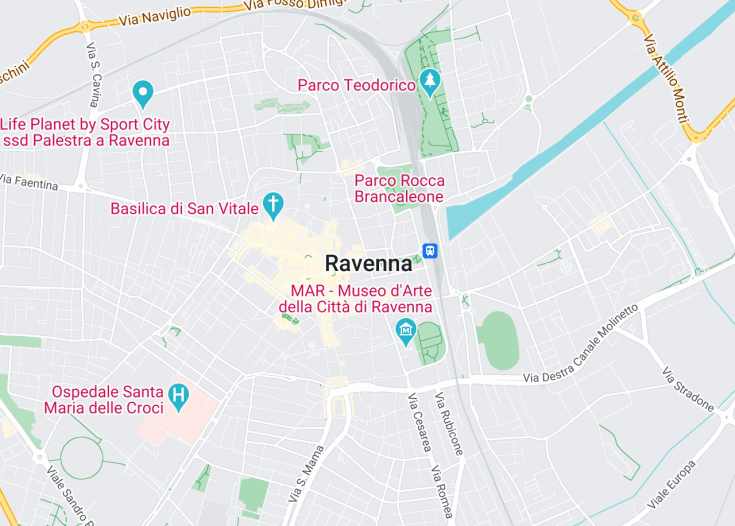Ravenna, a city rich in history and culture, stands out as a jewel in Italy’s Emilia-Romagna region. Known for its stunning early Christian and Byzantine mosaics, the city has eight UNESCO World Heritage Sites, attracting historians and art lovers alike. Its serene streets echo tales of its past as the capital of the Western Roman Empire. The city also offers delightful gastronomy, vibrant festivals, and a proximity to the Adriatic coast, making it a comprehensive destination for diverse interests.
For the best views of Ravenna’s renowned mosaics, plan your visit during the quieter morning hours to enjoy the sites in a more intimate setting.
Consider renting a bike to explore Ravenna at your own pace. It’s an eco-friendly way to cover more ground and discover hidden corners of the city.
Top things to do & see in Ravenna
Select the following sights and activities to discover best tickets and tours available in Ravenna.
Ravenna: A Mosaic of Histories and Cultures
| Country | Italy |
| Time in Ravenna | GMT+1 |
| Language spoken | Italian |
| Population | 159,057 (source: ISTAT, 2023) |
| Currency | Euro (€, EUR) |
| Airports |
|
Ravenna, an Italian city soaked in history and culture, is renowned for its striking Byzantine mosaics, which adorn its churches and monuments. As the capital of the Western Roman Empire in the 5th century, Ravenna played a critical role in the early Christian period, serving as a bridge between Western and Eastern Christian cultures. The city’s mosaics, a designated UNESCO World Heritage site, are among the best preserved in Europe and continue to draw scholars and tourists alike. The ancient city, once a vibrant seaport, is also celebrated for its important historical figures, such as the poet Dante Alighieri, who spent his last years here. Ravenna’s unique blend of art, history, and literature makes it a fascinating destination for anyone drawn to Italy’s extensive cultural tapestry.
Where is Ravenna?
Ravenna is located in the northeastern part of Italy, not far from the coast of the Adriatic Sea.
Distances:
| Route | Distance by car | Time by car |
|---|---|---|
| Rome to Ravenna | 345 km | Approximately 3.5 hours |
| Milan to Ravenna | 303 km | Approximately 3 hours |
What is Ravenna famous for?
Ravenna is famous for its well-preserved Byzantine mosaics. These extraordinary works of art can be observed in various basilicas and baptisteries, giving insight into the early Christian artistic culture.
History
Prehistoric to Roman Era
Ravenna’s history begins with its early settlements by the Umbri people, followed by the Etruscans and later, the Romans. The city gained prominence in 89 BC when it became a Roman municipium. Its strategic coastal location on the Adriatic and its port facilities played pivotal roles in its development during the Roman era, especially under Julius Caesar.
5th to 8th Century: Byzantine Exarchate
After the fall of the Roman Empire, Ravenna experienced a transformation under the Ostrogoths and later the Byzantines. It became the capital of the Western Roman Empire under Emperor Honorius in 402 AD, and later, the capital of the Ostrogothic Kingdom. When the Byzantines took over in 540 AD, Ravenna’s golden age began. The city became the seat of the Byzantine governor in Italy, known as the Exarch, and many of its famed mosaics date from this period.
9th Century to Renaissance
Following the dissolution of the Exarchate, Ravenna saw various rulers including the Lombards and Franks. In the middles ages, it became a self-governing commune. Despite facing challenges like marsh encroachments, it flourished as a hub for trade and culture, evidenced by the creation of many Romanesque and Gothic buildings during this period.
Modern Era
Entering the modern era, Ravenna became part of the Papal States until it was absorbed into the newly unified Kingdom of Italy in 1861. The 20th century saw the city both benefiting from and suffering due to industrialization and World War II, respectively. Today, it is renowned for its rich historical and cultural heritage, attracting scholars and tourists alike.
Visit Ravenna
What to see and do in Ravenna
Ravenna, a treasure trove of art, history, and culture, offers a myriad of attractions. Notably, its eight UNESCO World Heritage Sites, including the stunning Basilica of San Vitale, famed for its exceptional mosaics which depict scenes from the Old and New Testaments. The Mausoleum of Galla Placidia, adorned with mesmerizing mosaics, offers an intimate glimpse into the spiritual and artistic life of early Christians in Ravenna.
- Explore the ancient streets and discover the city’s vibrant history.
- Visit the serene Dante’s Tomb, where the great poet rests.
- Enjoy the local cuisine, especially its seafood, in the cozy restaurants scattered throughout the city.
Events in Ravenna
Ravenna hosts numerous events throughout the year, celebrating its rich Byzantine heritage. Notable among them is the Ravenna Festival, held in the summer, which features a mix of opera, music, dance, and theater, drawing performers and audiences from around the globe. The autumn brings the Ravenna Nightmare Film Festival, a must-visit for cinema enthusiasts interested in horror and thriller genres.
Best time to visit Ravenna
The ideal times to visit Ravenna are during spring (April to June) and fall (September and October). These months offer pleasant weather, fewer crowds, and the opportunity to fully enjoy the outdoor and cultural activities the city has to offer.
Is Ravenna worth visiting?
Ravenna is unquestionably worth a visit, particularly for those who appreciate art, history, and architecture. The city’s world-renowned mosaics offer a unique window into the past, showcasing the skill and artistry of earlier civilizations, while the vibrant cultural scene and gastronomic delights provide a contemporary contrast. Whether you’re a history buff, art lover, or simply in search of a rich cultural experience, Ravenna promises a captivating visit.









